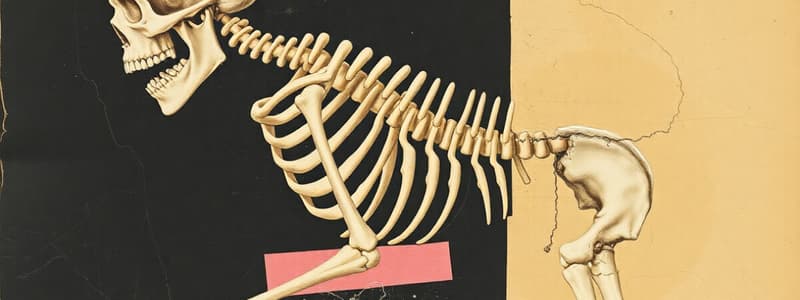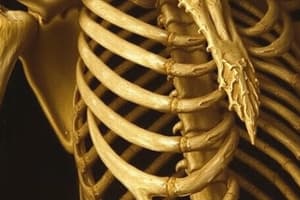Podcast
Questions and Answers
What type of connective tissue primarily composes cartilage?
What type of connective tissue primarily composes cartilage?
- Collagen and elastic fibers (correct)
- Adipose tissue
- Reticular fibers
- Nervous tissue
Which statement correctly describes the organization of chondrocytes in cartilage?
Which statement correctly describes the organization of chondrocytes in cartilage?
- Chondrocytes appear to be floating within the extracellular matrix. (correct)
- Chondrocytes are randomly arranged within the matrix. (correct)
- Chondrocytes form a layered structure.
- Chondrocytes are densely packed and aligned in rows.
Which component is primarily responsible for the solidity of bone tissue?
Which component is primarily responsible for the solidity of bone tissue?
- Mineralized matrix (correct)
- Chondroitin sulfate
- Ground substance
- Elastic fibers
What is the primary function of the extracellular matrix (ECM) in both cartilage and bone?
What is the primary function of the extracellular matrix (ECM) in both cartilage and bone?
Which type of connective tissue has no direct blood supply?
Which type of connective tissue has no direct blood supply?
What is the covering of cartilage called?
What is the covering of cartilage called?
What is a primary role of bones within the skeletal system?
What is a primary role of bones within the skeletal system?
In terms of organization, how are mineralized osteocytes arranged within bone tissue?
In terms of organization, how are mineralized osteocytes arranged within bone tissue?
Which of the following functions is NOT associated with bone?
Which of the following functions is NOT associated with bone?
What is the primary function of trabeculae in cancellous bone?
What is the primary function of trabeculae in cancellous bone?
What is the primary role of chondroitin sulfate in cartilage?
What is the primary role of chondroitin sulfate in cartilage?
What is the primary structural unit found in compact bone?
What is the primary structural unit found in compact bone?
Which type of bone is characterized by a dense and solid structure?
Which type of bone is characterized by a dense and solid structure?
What is found within the lacunae of compact bone?
What is found within the lacunae of compact bone?
Which type of cartilage is characterized by its glassy appearance?
Which type of cartilage is characterized by its glassy appearance?
What distinguishes fibrocartilage from other types of cartilage?
What distinguishes fibrocartilage from other types of cartilage?
What material primarily gives bone its hardness and compressive strength?
What material primarily gives bone its hardness and compressive strength?
What is the main difference between compact bone and cancellous bone in terms of blood supply?
What is the main difference between compact bone and cancellous bone in terms of blood supply?
What cellular structures house chondrocytes in cartilage?
What cellular structures house chondrocytes in cartilage?
Which mineral is primarily deposited in the extracellular matrix during the ossification process?
Which mineral is primarily deposited in the extracellular matrix during the ossification process?
Which of the following statements is true regarding lamellar bone?
Which of the following statements is true regarding lamellar bone?
What structure is absent in cancellous bone compared to compact bone?
What structure is absent in cancellous bone compared to compact bone?
What type of cartilage provides the most elasticity among its types?
What type of cartilage provides the most elasticity among its types?
What is the space at the core of the bone primarily filled with?
What is the space at the core of the bone primarily filled with?
Which type of cartilage primarily provides a gliding surface for the smooth movement of joints?
Which type of cartilage primarily provides a gliding surface for the smooth movement of joints?
What characteristic feature allows elastic cartilage to perform its function effectively?
What characteristic feature allows elastic cartilage to perform its function effectively?
What is a specific function of fibrocartilage in the body?
What is a specific function of fibrocartilage in the body?
Where is hyaline cartilage NOT typically found?
Where is hyaline cartilage NOT typically found?
How does the intervertebral disc help the spine?
How does the intervertebral disc help the spine?
What role does the epiglottis play in digestion and respiration?
What role does the epiglottis play in digestion and respiration?
Which statement about fibrocartilage is true?
Which statement about fibrocartilage is true?
What effect does pregnancy have on the symphysis pubis?
What effect does pregnancy have on the symphysis pubis?
What characterizes non-lamellar (woven) bone when compared to lamellar bone?
What characterizes non-lamellar (woven) bone when compared to lamellar bone?
Which area of long bones is referred to as the diaphysis?
Which area of long bones is referred to as the diaphysis?
What happens to the epiphyseal plate in adulthood?
What happens to the epiphyseal plate in adulthood?
How does drinking milk affect bone growth over time?
How does drinking milk affect bone growth over time?
Which statement about joints is true?
Which statement about joints is true?
What type of bone is found predominantly in the epiphyseal plate of growing long bones?
What type of bone is found predominantly in the epiphyseal plate of growing long bones?
Which type of bone develops from non-lamellar bone to reinforce its structure?
Which type of bone develops from non-lamellar bone to reinforce its structure?
Which of the following conditions results from underproduction of growth hormone?
Which of the following conditions results from underproduction of growth hormone?
Flashcards are hidden until you start studying
Study Notes
Skeletal System Overview
- Composed primarily of cartilage and bone, which are specialized types of connective tissue.
- Functions include supporting structural framework, facilitating locomotion, and protecting vital organs.
Cartilage Characteristics
- Contains chondrocytes surrounded by a gel-like extracellular matrix (ECM) rich in collagen and elastic fibers.
- Avascular; nutrients reach chondrocytes through the ECM.
Types of Cartilage
- Hyaline Cartilage: Most common form; glassy appearance; found at joint surfaces, rib tips, trachea, and nasal cartilage; provides a smooth surface for joint movement.
- Elastic Cartilage: Contains abundant elastic fibers; allows flexibility; found in the ear and epiglottis.
- Fibrocartilage: Reinforced with dense collagen fibers; provides strength and resistance to bending; found in intervertebral discs and knee meniscus.
Bone Characteristics
- Rigidity due to calcification, primarily composed of calcium phosphate.
- Vascularized; contains osteocytes within lacunae, allowing for nutrient distribution and waste removal.
- Divided into two types: Compact bone (dense, organized in osteons) and Spongy bone (porous, containing trabeculae).
Bone Structure
- Compact Bone: Dense, contains Haversian systems; blood vessels and nerves are housed in the osteonic canal; collagen structures provide compressive and tensile strength.
- Spongy Bone: Porous; lacks Haversian systems; contains bone marrow; facilitates nutrient exchange and structural support.
Bone Development
- Bone develops from non-lamellar (woven) bone to lamellar bone as it matures, reinforcing and strengthening it.
- Cortical bone forms the outer cortex; medullary bone fills the interior.
Long Bone Structure
- Epiphysis: Ends of long bones.
- Diaphysis: Shaft of the bone.
- Metaphysis: Region of growth (epiphyseal plate) between diaphysis and epiphysis; ossifies in adulthood.
Bone Growth
- Calcium intake (e.g., from milk) can contribute to bone strength but does not increase height if growth plates are closed.
- Growth hormone levels affect stature, associated with conditions like dwarfism and gigantism.
Joints Overview
- Points where two bones meet; classified structurally and functionally.
- Structural classification considers the tissues binding the bones and the presence of a synovial cavity, while functional classification evaluates the range of motion.
Studying That Suits You
Use AI to generate personalized quizzes and flashcards to suit your learning preferences.




